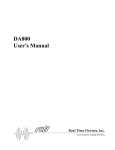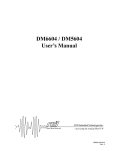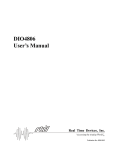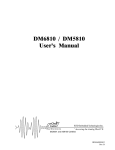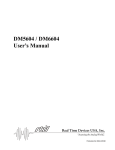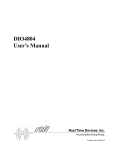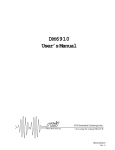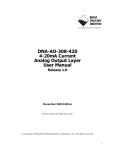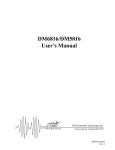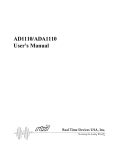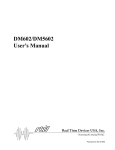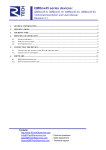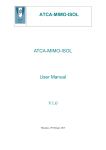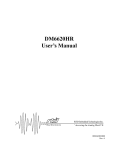Download DA720 User`s Manual
Transcript
DA720 User’s Manual ® Real Time Devices, Inc. “Accessing the Analog World”® DA720 User’s Manual ® REAL TIME DEVICES, INC. Post Office Box 906 State College, Pennsylvania 16804 Phone: (814) 234-8087 FAX: (814) 234-5218 Published by Real Time Devices, Inc. P.O. Box 906 State College, PA 16804 Copyright © 1993 by Real Time Devices, Inc. All rights reserved Printed in U.S.A. 9329 Table of Contents INTRODUCTION .................................................................................................................................... i-1 Digital-to-Analog Conversion ................................................................................................................................. i-3 What Comes With Your Board ............................................................................................................................... i-3 Board Accessories ................................................................................................................................................... i-3 Using This Manual .................................................................................................................................................. i-3 When You Need Help ............................................................................................................................................. i-3 CHAPTER 1 — BOARD SETTINGS .................................................................................................. 1-1 Factory-Configured Switch and Jumper Settings .................................................................................................. 1-3 P3 Through P10 — DAC1 Through DAC8 Output Range Select (Factory Setting: -5 to +5 Volts) ................ 1-4 S1 — Base Address (Factory Setting: 300 hex (768 decimal)) ............................................................................. 1-5 CHAPTER 2 — BOARD INSTALLATION ....................................................................................... 2-1 Board Installation ................................................................................................................................................... 2-3 External I/O Connections ....................................................................................................................................... 2-3 Connecting the Analog Outputs — Voltage Outputs ........................................................................................ 2-4 Running the 720DIAG Diagnostics Program ........................................................................................................ 2-4 CHAPTER 3 — HARDWARE DESCRIPTION ................................................................................. 3-1 D/A Conversion ..................................................................................................................................................... 3-3 CHAPTER 4 — BOARD OPERATION AND PROGRAMMING ................................................... 4-1 Defining the I/O Map ............................................................................................................................................. 4-3 BA + 0: D/A Converter 1 LSB/Update All DACs (Read/Write) ..................................................................... 4-4 BA + 1: D/A Converter 1 MSB (Write Only) .................................................................................................. 4-4 BA + 2: D/A Converter 2 LSB (Write Only) .................................................................................................... 4-4 BA + 3: D/A Converter 2 MSB (Write Only) .................................................................................................. 4-4 BA + 4: D/A Converter 3 LSB (Write Only) .................................................................................................... 4-4 BA + 5: D/A Converter 3 MSB (Write Only) .................................................................................................. 4-4 BA + 6: D/A Converter 4 LSB (Write Only) .................................................................................................... 4-4 BA + 7: D/A Converter 4 MSB (Write Only) .................................................................................................. 4-4 BA + 8: D/A Converter 5 LSB (Write Only) .................................................................................................... 4-4 BA + 9: D/A Converter 5 MSB (Write Only) .................................................................................................. 4-4 BA + 10: D/A Converter 6 LSB (Write Only) .................................................................................................. 4-4 BA + 11: D/A Converter 6 MSB (Write Only) ................................................................................................ 4-4 BA + 12: D/A Converter 7 LSB (Write Only) .................................................................................................. 4-5 BA + 13: D/A Converter 7 MSB (Write Only) ................................................................................................ 4-5 BA + 14: D/A Converter 8 LSB (Write Only) .................................................................................................. 4-5 BA + 15: D/A Converter 8 MSB (Write Only) ................................................................................................ 4-5 Programming the DA720 ....................................................................................................................................... 4-6 Clearing and Setting Bits in a Port ..................................................................................................................... 4-7 D/A Conversions ................................................................................................................................................ 4-8 Example Programs ............................................................................................................................................... 4-10 C and Pascal Programs .................................................................................................................................... 4-10 BASIC Programs ............................................................................................................................................. 4-10 i CHAPTER 5 — CALIBRATION ......................................................................................................... 5-1 Required Equipment ............................................................................................................................................... 5-3 D/A Calibration ...................................................................................................................................................... 5-4 X2 Voltage Multiplier ........................................................................................................................................ 5-4 APPENDIX A — DA720 SPECIFICATIONS ..................................................................................... A-1 APPENDIX B — I/O CONNECTOR PIN ASSIGNMENTS ............................................................. B-1 APPENDIX C — WARRANTY ............................................................................................................ C-1 ii List of Illustrations 1-1 1-2 1-3 2-1 2-2 3-1 5-1 Board Layout Showing Factory-Configured Settings .............................................................................. 1-4 AOUT1 Through AOUT8 DAC Output Ranges Select, P3 Through P10 ............................................... 1-5 Base Address Switch, S1 .......................................................................................................................... 1-6 P2 I/O Connector Pin Assignments .......................................................................................................... 2-3 Voltage Output Connections .................................................................................................................... 2-4 DA720 Block Diagram ............................................................................................................................. 3-3 Board Layout ............................................................................................................................................ 5-3 iii iv INTRODUCTION i-1 i-2 The DA720 Low Cost Industrial Control series analog output board turns your IBM PC/XT/AT or compatible into a high-performance testing and control system. Installed within a single short or full-size expansion slot in the computer, the DA720 board features: • • • • 8 fast-settling 12-bit analog output channels, ±5, ±10, 0 to +5, or 0 to +10 volt analog output range, Simultaneous updating of all output channels, BASIC, Turbo Pascal & Turbo C source code; diagnostic program. The following paragraphs briefly describe the major functions of the board. More detailed discussions of board functions are included in Chapter 3, Hardware Description, and Chapter 4, Board Operation and Programming. The board setup is described in Chapter 1, Board Settings. Digital-to-Analog Conversion The digital-to-analog (D/A) circuitry features two 12-bit converter channels in each AD7237 D/A converter IC for a total of eight output channels. The two channels in each AD7237 are internally double buffered and all channels are simultaneously updated by issuing a single command. Each channel can be jumpered to one of four output voltage ranges, ±5, ±10, 0 to +5, or 0 to +10. What Comes With Your Board You receive the following items in your DA720 package: • DA720 interface board • Software and diagnostics diskette with BASIC, Turbo Pascal, and Turbo C source code • User’s manual If any item is missing or damaged, please call Real Time Devices’ Customer Service Department at (814) 234-8087. If you require service outside the U.S., contact your local distributor. Board Accessories In addition to the items included in your DA720 package, Real Time Devices offers a full line of accessories. Call your local distributor or our main office for more information about these accessories and for help in choosing the best items to support your board’s application. Accessories for the DA720 include the TB50 terminal board and XB50 prototype/terminal board for prototype development and easy signal access, and the XT50 twisted pair wire flat ribbon cable assembly for external interfacing. Using This Manual This manual is intended to help you install your new board and get it running quickly, while also providing enough detail about the board and its functions so that you can enjoy maximum use of its features even in the most complex applications. We assume that you already have an understanding of data acquisition principles and that you can customize the example software or write your own applications programs. When You Need Help This manual and the example programs in the software package included with your board provide enough information to properly use all of the board’s features. If you have any problems installing or using this board, contact our Technical Support Department, (814) 234-8087, during regular business hours, eastern standard time or eastern daylight time, or send a FAX requesting assistance to (814) 234-5218. When sending a FAX request, please include your company’s name and address, your name, your telephone number, and a brief description of the problem. i-3 i-4 CHAPTER 1 BOARD SETTINGS The DA720 board has jumper and switch settings you can change if necessary for your application. The board is factoryconfigured as listed in the table and shown on a diagram in the beginning of this chapter. Should you need to change these settings, use these easy-to-follow instructions before you install the board in your computer. 1-1 1-2 Factory-Configured Switch and Jumper Settings Table 1-1 lists the factory settings of the user-configurable jumper and switches on the DA720 board. Figure 1-1 shows the board layout and the locations of the factory-set jumpers. The following paragraphs explain how to change the factory settings. Pay special attention to the setting of S1, the base address switch, to avoid address contention when you first use your board in your system. Table 1-1: Factory Settings Switch/ Jumper Function Controlled Factory Settings (Jumpers Installed) P3 Configures the output voltage range settings for DAC1 Jumpers installed on ±5 & X1 to set output at -5 to +5 volts P4 Configures the output voltage range settings for DAC2 Jumpers installed on ±5 & X1 to set output at -5 to +5 volts P5 Configures the output voltage range settings for DAC3 Jumpers installed on ±5 & X1 to set output at -5 to +5 volts P6 Configures the output voltage range settings for DAC4 Jumpers installed on ±5 & X1 to set output at -5 to +5 volts P7 Configures the output voltage range settings for DAC5 Jumpers installed on ±5 & X1 to set output at -5 to +5 volts P8 Configures the output voltage range settings for DAC6 Jumpers installed on ±5 & X1 to set output at -5 to +5 volts P9 Configures the output voltage range settings for DAC7 Jumpers installed on ±5 & X1 to set output at -5 to +5 volts P10 Configures the output voltage range settings for DAC8 Jumpers installed on ±5 & X1 to set output at -5 to +5 volts S1 Sets the base address 300 hex (768 decimal) 1-3 TR1 BASE ADDRESS TR2 TR3 TR5 TR4 TR6 TR7 TR8 S1 R SWITCH USA ,, Accessing the Analog World RN1 ,, R RN3 RN6 RN2 RN5 U6 U7 P3 5 C25 X1 C26 AD712 AD7237 X2 5 P2 P7 5 + - P9 5 + - AD7237 X2 5 C31 X1 C32 C23 X1 RN7 U13 P10 C24 C15 C16 5 C30 X2 AOUT7 5 + - X1 AOUT8 U12 C29 AD712 AD7237 X2 5 C21 X1 U11 P8 C22 C13 C14 5 AOUT5 5 + - C27 C28 X2 AOUT6 U10 5 X1 AD712 AD7237 X2 AD712 5 + - C19 P5 C20 X1 P6 AOUT4 C11 C12 5 U9 AOUT3 5 RN4 X2 U8 + - C17 + - C18 X1 P4 AOUT1 C9 C10 5 AOUT2 5 + - X2 C3 DA720 74LS139 U3 C4 74LS367 U4 74LS32 74LS245 + U1 U5 U2 + C1 C5 C2 74LS688 8 Channel Digital / Analog Converter Board 12 Bit Resolution + C7 C8 C33 C9 + A31 Copyright C 1993 Real Time Devices, Inc. State College, PA 16804 USA P1 A1 Fig. 1-1 — Board Layout Showing Factory-Configured Settings P3 Through P10 — DAC1 Through DAC8 Output Range Select (Factory Setting: -5 to +5 Volts) These identical header connectors, shown in Figure 1-2, let you independently set the output of each D/A converter to one of four voltage ranges. AOUT1 is set on P3, AOUT2 is set on P4, and so on through AOUT8, which is set on P10. Figure 1-2 shows all four possible configurations for these headers, and the table below summarizes these settings. The top pair of pins, 5V, is jumpered when operating in a unipolar voltage range. The next pair of pins, ±5V, is jumpered when operating in a bipolar voltage range (±5 or ±10 volts). The X1 and X2 pins set the range multiplier. When a jumper is installed across X1, the multiplier is set at times 1 for 0 to +5 and ±5 volt ranges. When the jumper is installed across X2, the multiplier is times 2 for 0 to +10 and ±10 volt ranges. The factory setting of each DAC is shown in Figure 1-2a, ±5 volts. Output Range Jumpers (left to right) ±5V 0 to +5V ±10V 0 to +10V 5V OFF ON OFF ON ±5V ON OFF ON OFF X1 ON ON OFF OFF X2 OFF OFF ON ON 1-4 5 5 5 5 ±5 ±5 ±5 ±5 X1 X1 X1 X1 X2 X2 X2 X2 Fig. 1-2a — ±5V Output Fig. 1-2b — 0 to +5V Output Fig. 1-2c — ±10V Output Fig. 1-2d — 0 to +10V Output Fig. 1-2 — AOUT1 Through AOUT8 DAC Output Range Select, P3 Through P10 S1 — Base Address (Factory Setting: 300 hex (768 decimal)) One of the most common causes of failure when you are first trying your board is address contention. Some of your computer’s I/O space is already occupied by internal I/O and other peripherals. When the DA720 board attempts to use I/O address locations already used by another device, contention results and the board does not work. To avoid this problem, the DA720 has an easily accessible DIP switch, S1, which lets you select any one of 32 starting addresses in the computer’s I/O. Should the factory setting of 300 hex (768 decimal) be unsuitable for your system, you can select a different base address simply by setting the switches to any value shown in Table 1-2. The table shows the switch settings and their corresponding decimal and hexadecimal (in parentheses) values. Make sure that you verify the order of the switch numbers on the switch (1 through 5) before setting them. When the switches are pulled forward, they are OPEN, or set to logic 1, as labeled on the DIP switch package. When you set the base address for your board, record the value in the table inside the back cover. Figure 1-3 shows the DIP switch set for a base address of 300 hex (768 decimal). Table 1-2 Base Address Switch Settings, S1 Base Address Decimal / (Hex) Switch Setting 5 4 3 2 1 Base Address Decimal / (Hex) Switch Setting 5 4 3 2 1 512 / (200) 0 0 0 0 0 768 / (300) 1 0 0 0 0 528 / (210) 0 0 0 0 1 784 / (310) 1 0 0 0 1 544 / (220) 0 0 0 1 0 800 / (320) 1 0 0 1 0 560 / (230) 0 0 0 1 1 816 / (330) 1 0 0 1 1 576 / (240) 0 0 1 0 0 832 / (340) 1 0 1 0 0 592 / (250) 0 0 1 0 1 848 / (350) 1 0 1 0 1 608 / (260) 0 0 1 1 0 864 / (360) 1 0 1 1 0 624 / (270) 0 0 1 1 1 880 / (370) 1 0 1 1 1 640 / (280) 0 1 0 0 0 896 / (380) 1 1 0 0 0 656 / (290) 0 1 0 0 1 912 / (390) 1 1 0 0 1 672 / (2A0) 0 1 0 1 0 928 / (3A0) 1 1 0 1 0 688 / (2B0) 0 1 0 1 1 944 / (3B0) 1 1 0 1 1 704 / (2C0) 0 1 1 0 0 960 / (3C0) 1 1 1 0 0 720 / (2D0) 0 1 1 0 1 976 / (3D0) 1 1 1 0 1 736 / (2E0) 0 1 1 1 0 992 / (3E0) 1 1 1 1 0 752 / (2F0) 0 1 1 1 1 1008 / (3F0) 1 1 1 1 1 0 = closed, 1 = open 1-5 Fig. 1-3 — Base Address Switch, S1 1-6 CHAPTER 2 BOARD INSTALLATION The DA720 board is easy to install in your IBM PC/XT/AT or compatible computer. This chapter tells you step-by-step how to install and connect the board for voltage outputs. After you have installed the board and made all of your connections, you can turn your system on and run the 720DIAG board diagnostics program included on your example software disk to verify that your board is working. 2-1 2-2 Board Installation Keep the board in its antistatic bag until you are ready to install it in your computer. When removing it from the bag, hold the board at the edges and do not touch the components or connectors. Before installing the board in your computer, check the jumper settings. Chapter 1 reviews the factory settings and how to change them. If you need to change any settings, refer to the appropriate instructions in Chapter 1. Note that incompatible settings can result in unpredictable board operation and erratic response. To install the board: 1. Turn OFF the power to your computer. 2. Remove the top cover of the computer housing (refer to your owner’s manual if you do not already know how to do this). 3. Select any unused short or full-size expansion slot and remove the slot bracket. 4. Touch the metal housing of the computer to discharge any static buildup and then remove the board from its antistatic bag. 5. Holding the board by its edges, orient it so that its card edge (bus) connector lines up with the expansion slot connector in the bottom of the selected expansion slot. 6. After carefully positioning the board in the expansion slot so that the card edge connector is resting on the computer’s bus connector, gently and evenly press down on the board until it is secured in the slot. NOTE: Do not force the board into the slot. If the board does not slide into place, remove it and try again. Wiggling the board or exerting too much pressure can result in damage to the board or to the computer. 7. After the board is installed, secure the slot bracket back into place and put the cover back on your computer. The board is now ready to be connected via the external I/O connector at the rear panel of your computer. External I/O Connections Figure 2-1 shows the DA720’s P2 I/O connector pinout. Refer to this diagram as you make your I/O connections. AOUT1 1 2 ANALOG GND AOUT2 3 4 ANALOG GND AOUT3 5 6 ANALOG GND AOUT4 7 8 ANALOG GND AOUT5 9 10 ANALOG GND AOUT6 11 12 ANALOG GND AOUT7 13 14 ANALOG GND AOUT8 15 16 ANALOG GND N. C. 17 18 N. C. N. C. 19 20 N. C. N. C. 21 22 N. C. N. C. 23 24 N. C. N. C. 25 26 N. C. N. C. 27 28 N. C. N. C. 29 30 N. C. N. C. 31 32 N. C. N. C. 33 34 N. C. N. C. 35 36 N. C. N. C. 37 38 N. C. N. C. 39 40 N. C. N. C. 41 42 N. C. N. C. 43 44 N. C. N. C. 45 46 N. C. +12 VOLTS 47 48 +5 VOLTS -12 VOLTS 49 50 DIGITAL GND Fig. 2-1 — P2 I/O Connector Pin Assignments 2-3 Connecting the Analog Outputs — Voltage Outputs To connect a channel’s voltage output, the high side of the device receiving the output is connected to an AOUT line and the low side is connected to the corresponding ANALOG GND. Figure 2-2 shows how to connect the DA720 outputs to a load. OP- AMP BUFFERS AD7 1 2 720 I/ O CONNECTOR P2 PIN 1 AOUT 1 LOAD AD7 1 2 PIN 2 ANALOG GND PIN 15 AOUT 8 LOAD PIN 16 ANALOG GND Fig. 2-2 — Voltage Output Connections Running the 720DIAG Diagnostics Program Now that your board is ready to use, you will want to try it out. An easy-to-use, menu-driven diagnostics program, 720DIAG, is included with your example software to help you verify your board’s operation. You can also use this program to make sure that your current base address setting does not contend with another device. 2-4 CHAPTER 3 HARDWARE DESCRIPTION This chapter describes the features of the DA720’s D/A circuit. 3-1 3-2 The DA720 provides eight analog output channels with voltage outputs, as shown Figure 3-1. This chapter describes the hardware which makes up this circuit. VOLTAGE SELECT 12-BIT D/A CONVERTER VOLTAGE SELECT 12-BIT D/A CONVERTER VOLTAGE SELECT 12-BIT D/A CONVERTER VOLTAGE SELECT DATA VOLTAGE SELECT VOLTAGE SELECT VOLTAGE SELECT VOLTAGE SELECT AOUT1 AOUT2 AOUT3 AOUT4 AOUT5 AOUT6 AOUT7 AOUT8 ±12 VOLTS CONTROL +5 VOLTS Fig. 3-1 — DA720 Block Diagram D/A Conversion The DA720 board performs digital-to-analog conversions on eight independent analog output channels. The output of each conversion channel is jumper-selectable for ±5, ±10, 0 to +5, or 0 to +10 volts. The AD7237 12-bit D/A converter contains two independent D/A converter channels in a single CMOS package. The data to be converted is double buffered at the D/A input, which allows simultaneous updating of all eight D/A output channels. The AD712 precision operational amplifier provides complete coverage of the output voltage ranges. The exceptionally low offset voltage and drift ensure an accurate analog output on each channel. 3-3 I/O CONNECTOR ADDRESS DECODE PC BUS ADDRESS 12-BIT D/A CONVERTER 3-4 CHAPTER 4 BOARD OPERATION AND PROGRAMMING This chapter shows you how to program and use your DA720 board. It provides a complete description of the I/O map and programming operations to aid you in programming. The example programs included on the disk in your board package are listed at the end of this chapter. These programs, written in Turbo C, Turbo Pascal, and BASIC, include source code to simplify your applications programming. 4-1 4-2 Defining the I/O Map The I/O map for the DA720 is shown in Table 4-1 below. As shown, the board occupies 16 consecutive I/O port locations. The base address (designated as BA) can be selected using DIP switch S1 as described in Chapter 1, Board Settings. This switch can be accessed without removing the board from the connector. The following sections describe the register contents of each address used in the I/O map. Table 4-1: DA720 I/O Map Read Function Updates the outputs of all DACs Program DAC1 LSB BA + 0 D/A Converter 1 MSB Reserved Program DAC1 MSB BA + 1 D/A Converter 2 LSB Reserved Program DAC2 LSB BA + 2 D/A Converter 2 MSB Reserved Program DAC2 MSB BA + 3 D/A Converter 3 LSB Reserved Program DAC3 LSB BA + 4 D/A Converter 3 MSB Reserved Program DAC3 MSB BA + 5 D/A Converter 4 LSB Reserved Program DAC4 LSB BA + 6 D/A Converter 4 MSB Reserved Program DAC4 MSB BA + 7 D/A Converter 5 LSB Reserved Program DAC5 LSB BA + 8 D/A Converter 5 MSB Reserved Program DAC5 MSB BA + 9 D/A Converter 6 LSB Reserved Program DAC6 LSB BA + 10 D/A Converter 6 MSB Reserved Program DAC6 MSB BA + 11 D/A Converter 7 LSB Reserved Program DAC7 LSB BA + 12 D/A Converter 7 MSB Reserved Program DAC7 MSB BA + 13 D/A Converter 8 LSB Reserved Program DAC8 LSB BA + 14 D/A Converter 8 MSB Reserved Program DAC8 MSB BA + 15 * BA = Base Address 4-3 Write Function Address * (Decimal) Register Description D/A Converter 1 LSB/ Update All DACs BA + 0: D/A Converter 1 LSB/Update All DACs (Read/Write) A write programs the DAC1 LSB (eight bits). A read simultaneously updates the outputs of all eight channels. BA + 1: D/A Converter 1 MSB (Write Only) Programs the DAC1 MSB (four bits) into D0 through D3; D4 through D7 are irrelevant. DAC LSB D7 D6 D5 D4 D3 D2 D1 D0 Bit 7 DAC MSB Bit 6 Bit 5 Bit 4 Bit 3 Bit 2 Bit 1 Bit 0 D7 D6 D5 D4 D3 D2 D1 D0 X X X X Bit 11 Bit 10 Bit 9 Bit 8 BA + 2: D/A Converter 2 LSB (Write Only) Programs the DAC2 LSB (eight bits). BA + 3: D/A Converter 2 MSB (Write Only) Programs the DAC2 MSB (four bits) into D0 through D3; D4 through D7 are irrelevant. BA + 4: D/A Converter 3 LSB (Write Only) Programs the DAC3 LSB (eight bits). BA + 5: D/A Converter 3 MSB (Write Only) Programs the DAC3 MSB (four bits) into D0 through D3; D4 through D7 are irrelevant. BA + 6: D/A Converter 4 LSB (Write Only) Programs the DAC4 LSB (eight bits). BA + 7: D/A Converter 4 MSB (Write Only) Programs the DAC4 MSB (four bits) into D0 through D3; D4 through D7 are irrelevant. BA + 8: D/A Converter 5 LSB (Write Only) Programs the DAC5 LSB (eight bits). BA + 9: D/A Converter 5 MSB (Write Only) Programs the DAC5 MSB (four bits) into D0 through D3; D4 through D7 are irrelevant. BA + 10: D/A Converter 6 LSB (Write Only) Programs the DAC6 LSB (eight bits). BA + 11: D/A Converter 6 MSB (Write Only) Programs the DAC6 MSB (four bits) into D0 through D3; D4 through D7 are irrelevant. 4-4 BA + 12: D/A Converter 7 LSB (Write Only) Programs the DAC7 LSB (eight bits). BA + 13: D/A Converter 7 MSB (Write Only) Programs the DAC7 MSB (four bits) into D0 through D3; D4 through D7 are irrelevant. BA + 14: D/A Converter 8 LSB (Write Only) Programs the DAC8 LSB (eight bits). BA + 15: D/A Converter 8 MSB (Write Only) Programs the DAC8 MSB (four bits) into D0 through D3; D4 through D7 are irrelevant. 4-5 Programming the DA720 This section gives you some general information about programming and the DA720 board, and then walks you through the major DA720 programming functions. These descriptions will help you as you use the example programs included with the board. All of the program descriptions in this section use decimal values unless otherwise specified. The DA720 is programmed by writing to and reading from the correct I/O port locations on the board. These I/O ports were defined in the previous section. Most high-level languages such as BASIC, Pascal, C, and C++, and of course assembly language, make it very easy to read/write these ports. The table below shows you how to read from and write to I/O ports using some popular programming languages. /DQJXDJH %$6,& 7XUER& 7XUER3DVFDO $VVHPEO\ 5HDG 'DWD ,13$GGUHVV :ULWH 287$GGUHVV'DWD 'DWD LQSRUWE$GGUHVV RXWSRUWE$GGUHVV'DWD 'DWD 3RUW>$GGUHVV@ 3RUW>$GGUHVV@ 'DWD PRYG[$GGUHVV LQDOG[ PRYG[$GGUHVV PRYDO'DWD RXWG[DO In addition to being able to read/write the I/O ports on the DA720, you must be able to perform a variety of operations that you might not normally use in your programming. The table below shows you some of the operators discussed in this section, with an example of how each is used with Pascal, C, and BASIC. Note that the modulus operator is used to retrieve the least significant byte (LSB) of a two-byte word, and the integer division operator is used to retrieve the most significant byte (MSB). /DQJXDJH 0RGXOXV ,QWHJHU'LYLVLRQ $1' 25 & D EF D EF D EF _ D E_F 3DVFDO 02' D E02'F ',9 D E',9F $1' D E$1'F 25 D E25F %$6,& 02' D E02'F ? D E?F $1' D E$1'F 25 D E25F Many compilers have functions that can read/write either 8 or 16 bits from/to an I/O port. For example, Turbo Pascal uses Port for 8-bit port operations and PortW for 16 bits, Turbo C uses inportb for an 8-bit read of a port and inport for a 16-bit read. Be sure to use only 8-bit operations with the DA720! 4-6 Clearing and Setting Bits in a Port When you clear or set one or more bits in a port, you must be careful that you do not change the status of the other bits. You can preserve the status of all bits you do not wish to change by proper use of the AND and OR binary operators. Using AND and OR, single or multiple bits can be easily cleared in one operation. To clear a single bit in a port, AND the current value of the port with the value b, where b = 255 - 2 bit. Example: Clear bit 5 in a port. Read in the current value of the port, AND it with 223 (223 = 255 - 25), and then write the resulting value to the port. In BASIC, this is programmed as: V = INP(PortAddress) V = V AND 223 OUT PortAddress, V To set a single bit in a port, OR the current value of the port with the value b, where b = 2bit. Example: Set bit 3 in a port. Read in the current value of the port, OR it with 8 (8 = 23), and then write the resulting value to the port. In Pascal, this is programmed as: V := Port[PortAddress]; V := V OR 8; Port[PortAddress] := V; Setting or clearing more than one bit at a time is accomplished just as easily. To clear multiple bits in a port, AND the current value of the port with the value b, where b = 255 - (the sum of the values of the bits to be cleared). Note that the bits do not have to be consecutive. Example: Clear bits 2 ,4, and 6 in a port. Read in the current value of the port, AND it with 171 (171 = 255 - 22 - 24 - 26), and then write the resulting value to the port. In C, this is programmed as: v = inportb(port_address); v = v & 171; outportb(port_address, v); To set multiple bits in a port, OR the current value of the port with the value b, where b = the sum of the individual bits to be set. Note that the bits to be set do not have to be consecutive. Example: Set bits 3, 5, and 7 in a port. Read in the current value of the port, OR it with 168 (168 = 23 + 25 + 27), and then write the resulting value back to the port. In assembly language, this is programmed as: mov dx, PortAddress in al, dx or al, 168 out dx, al Often, assigning a range of bits is a mixture of setting and clearing operations. You can set or clear each bit individually or use a faster method of first clearing all the bits in the range then setting only those bits that must be set using the method shown above for setting multiple bits in a port. The following example shows how this twostep operation is done. Example: Assign bits 3, 4, and 5 in a port to 101 (bits 3 and 5 set, bit 4 cleared). First, read in the port and clear bits 3, 4, and 5 by ANDing them with 199. Then set bits 3 and 5 by ORing them with 40, and finally write the resulting value back to the port. In C, this is programmed as: v = inportb(port_address); v = v & 199; v = v | 40; outportb(port_address, v); 4-7 A final note: Don’t be intimidated by the binary operators AND and OR and try to use operators for which you have a better intuition. For instance, if you are tempted to use addition and subtraction to set and clear bits in place of the methods shown above, DON’T! Addition and subtraction may seem logical, but they will not work if you try to clear a bit that is already clear or set a bit that is already set. For example, you might think that to set bit 5 of a port, you simply need to read in the port, add 32 (25) to that value, and then write the resulting value back to the port. This works fine if bit 5 is not already set. But, what happens when bit 5 is already set? Bits 0 to 4 will be unaffected and we can’t say for sure what happens to bits 6 and 7, but we can say for sure that bit 5 ends up cleared instead of being set. A similar problem happens when you use subtraction to clear a bit in place of the method shown above. Now that you know how to clear and set bits, we are ready to look at the programming steps for the DA810 board functions. D/A Conversions D/A conversions are performed on the eight analog output channels, AOUT1 through AOUT8, by writing data to the D/A converter registers and then issuing an update command by performing a read at BA + 0 which simultaneously updates the outputs of all eight channels. The 12-bit digital data for each channel is loaded in a two step process, LSB followed by MSB. After the data has been loaded for all desired channels, the channels are simultaneously updated by issuing the update command. If a channel’s data has not been updated since the last conversion, the output of the DAC will not change. The digital data is converted to a corresponding voltage which is present at the output until new data is loaded and another update command is issued. The output voltage ranges are determined by the settings of the AOUT channel jumpers on P3 through P10. The following tables show key digital inputs and their corresponding outputs for unipolar and bipolar voltage ranges. The resolution for 0 to +5 volts is 1.22 millivolts; for 0 to +10 and ±5 volts, 2.44 millivolts; and for ±10 volts, 4.88 millivolts. D/A Converter Unipolar Calibration Table Ideal Output Voltage (in millivolts) D/A Bit Weight 0 to +5 V 0 to +10 V 4095 (Max. Output) 4998.8 9997.6 2048 2500.0 5000.0 1024 1250.0 2500.0 512 625.00 256 312.50 625.00 128 156.250 312.50 64 78.125 156.250 32 39.063 78.125 16 19.5313 39.063 8 9.7656 19.5313 4 4.8828 9.7656 2 2.4414 4.8828 1 1.2207 2.4414 0 0.0000 0.0000 4-8 1250.0 D/A Converter Bipolar Calibration Table Ideal Output Voltage (in millivolts) D/A Bit Weight ±5 V ±10 V 4095 (Max. Output) +4997.6 +9995.1 2048 0.0 0.0 1024 -2500.0 -5000.0 512 -3750.0 -7500.0 256 -4375.0 -8750.0 128 -4687.5 -9375.0 64 -4843.8 -9687.5 32 -4921.9 -9843.8 16 -4960.9 -9921.9 8 -4980.5 -9960.9 4 -4990.2 -9980.5 2 -4995.1 -9990.2 1 -4997.6 -9995.1 0 -5000.0 -10000.0 4-9 Example Programs Included with the DA720 is a set of example programs that demonstrate the use of many of the board’s features. These examples are in written in C, Pascal, and BASIC. Also included is an easy-to-use menu-driven diagnostics program, 720DIAG, which is especially helpful when you are first checking out your board after installation. Before using the software included with your board, make a backup copy of the disk. You may make as many backups as you need. C and Pascal Programs This program is source code files so that you can easily develop your own custom software for your DA720. DAC Simple program that shows how to program the D/A converters. BASIC Programs This program is source code files so that you can easily develop your own custom software for your DA720. DAC Simple program that shows how to program the D/A converters. 4-10 CHAPTER 5 CALIBRATION This chapter tells you how to calibrate the DA720 using the 720DIAG calibration program included in the example software package and eight trimpots on the board. These trimpots calibrate the D/A X2 multiplier output. 5-1 5-2 This chapter tells you how to calibrate the D/A converter X2 voltage multiplier. The X1 range does not have to be calibrated. All D/A ranges are factory-calibrated before shipping. Any time you suspect inaccurate readings, you can check the accuracy of your conversions using the procedure below, and make adjustments as necessary. Using the 720DIAG diagnostics program is a convenient way to monitor conversions while you calibrate the board. Calibration is done with the board installed in your system. You can access the trimpots along the top edge of the board. Power up the system and let the board circuitry stabilize for 15 minutes before you start calibrating. Required Equipment The following equipment is required for calibration: • Digital Multimeter: 5-1/2 digits • Small Screwdriver (for trimpot adjustment) While not required, the 720DIAG diagnostics program (included with example software) is helpful when performing calibrations. Figure 5-1 shows the board layout with the eight trimpots located along the top edge of the board (TR1 through TR8, left to right). TR1 BASE ADDRESS TR2 TR3 TR5 TR4 TR6 TR7 TR8 S1 R SWITCH USA ,, Accessing the Analog World RN1 ,, R RN3 RN6 RN2 RN5 U6 X1 C26 AD7237 P2 P5 C28 X2 C29 X1 C30 AD7237 X2 5 +5 - C31 X1 C32 AD7237 X2 C23 P9 C24 C15 C16 X1 U13 P10 AOUT7 5 +5 - AOUT8 U12 RN7 X2 AD712 AD7237 X1 AD712 5 +5 - C21 P7 C22 C13 C14 P8 AOUT5 U11 5 +5 - AOUT6 U10 C27 X1 C19 X2 5 +5 - C20 AOUT3 AOUT4 C11 C12 X1 P6 U9 AD712 5 RN4 X2 U8 +5 - C17 C25 C18 X2 U7 5 +5 - AD712 P3 AOUT1 C9 C10 X1 P4 AOUT2 5 +5 - X2 C3 DA720 74LS139 U3 C4 74LS367 U4 U2 + C1 C5 C2 74LS688 8 Channel Digital / Analog Converter Board 12 Bit Resolution 74LS32 74LS245 + U1 U5 + C9 + A31 Copyright C 1993 Real Time Devices, Inc. State College, PA 16804 USA Fig. 5-1 — Board Layout 5-3 P1 A1 C7 C8 C33 D/A Calibration X2 Voltage Multiplier The D/A converter requires no calibration for the X1 ranges (0 to +5 and ±5 volts). The following paragraph describes the calibration procedure for the X2 multiplier ranges. To calibrate for X2 (0 to +10 or ±10 volts), set the DAC output voltage range to 0 to +10 volts (jumpers on 5V and X2 on the corresponding header connector which configures the DAC output for the channel you are calibrating). Then, program the D/A converter of the channel you are calibrating with the digital value 2048. The ideal DAC output for 2048 at X2 (0 to +10 volt range) is 5.0000 volts. Adjust the appropriate trimpot as listed in Table 5-1 until an output of 5.0000 volts is obtained. Repeat this procedure for all channels. Table 5-2 list the ideal output voltages for all bit weights in the unipolar ranges, and Table 5-3 lists the ideal output voltages for the bipolar ranges. Table 5-1: X2 Voltage Adjustment AOUT1 TR1 AOUT2 TR2 AOUT3 TR3 AOUT4 TR4 AOUT5 TR5 AOUT6 TR6 AOUT7 TR7 AOUT8 TR8 Table 5-2: D/A Converter Unipolar Calibration Table Ideal Output Voltage (in millivolts) D/A Bit Weight 0 to +5 V 0 to +10 V 4095 (Max. Output) 4998.8 9997.6 2048 2500.0 5000.0 1024 1250.0 2500.0 512 625.00 256 312.50 625.00 128 156.250 312.50 64 78.125 156.250 32 39.063 78.125 16 19.5313 39.063 8 9.7656 19.5313 4 4.8828 9.7656 2 2.4414 4.8828 1 1.2207 2.4414 0 0.0000 0.0000 5-4 1250.0 Table 5-3: D/A Converter Bipolar Calibration Table Ideal Output Voltage (in millivolts) D/A Bit Weight ±5 V ±10 V 4095 (Max. Output) +4997.6 +9995.1 2048 0.0 0.0 1024 -2500.0 -5000.0 512 -3750.0 -7500.0 256 -4375.0 -8750.0 128 -4687.5 -9375.0 64 -4843.8 -9687.5 32 -4921.9 -9843.8 16 -4960.9 -9921.9 8 -4980.5 -9960.9 4 -4990.2 -9980.5 2 -4995.1 -9990.2 1 -4997.6 -9995.1 0 -5000.0 -10000.0 5-5 5-6 APPENDIX A DA720 SPECIFICATIONS A-1 A-2 DA720 Characteristics Typical @ 25° C Interface Switch-selectable base address, I/O mapped D/A Converter ......................................................................................... AD7237 Analog outputs ............................................................................................. 8 channels Resolution ........................................................................................................... 12 bits Output ranges ............................................................ 0 to +5, ±5, 0 to +10, or ±10 volts Relative accuracy ...................................................................................... ±1 LSB, max Full-scale accuracy .................................................................................... ±5 LSB, max Non-linearity .............................................................................................. ±1 LSB, max Settling time .................................................................................................. 5 µsec, typ Current Requirements 66 mA @ +5V; 22 mA @ +12V; 16 mA @ –12V P2 I/O Connector 50-pin right angle shrouded box header Size 3.875"H x 5.25"W (99mm x 134mm) A-3 A-4 APPENDIX B I/O CONNECTOR PIN ASSIGNMENTS B-1 B-2 I/O Connector P2: AOUT1 1 2 ANALOG GND AOUT2 3 4 ANALOG GND AOUT3 5 6 ANALOG GND AOUT4 7 8 ANALOG GND AOUT5 9 10 ANALOG GND AOUT6 11 12 ANALOG GND AOUT7 13 14 ANALOG GND AOUT8 15 16 ANALOG GND N. C. 17 18 N. C. N. C. 19 20 N. C. N. C. 21 22 N. C. N. C. 23 24 N. C. N. C. 25 26 N. C. N. C. 27 28 N. C. N. C. 29 30 N. C. N. C. 31 32 N. C. N. C. 33 34 N. C. N. C. 35 36 N. C. N. C. 37 38 N. C. N. C. 39 40 N. C. N. C. 41 42 N. C. N. C. 43 44 N. C. N. C. 45 46 N. C. +12 VOLTS 47 48 +5 VOLTS -12 VOLTS 49 50 DIGITAL GND P2 Mating Connector Part Numbers Manufacturer Part Number AMP 1-746094-0 3M 3425-7650 B-3 B-4 APPENDIX C WARRANTY C-1 C-2 LIMITED WARRANTY Real Time Devices, Inc. warrants the hardware and software products it manufactures and produces to be free from defects in materials and workmanship for one year following the date of shipment from REAL TIME DEVICES. This warranty is limited to the original purchaser of product and is not transferable. During the one year warranty period, REAL TIME DEVICES will repair or replace, at its option, any defective products or parts at no additional charge, provided that the product is returned, shipping prepaid, to REAL TIME DEVICES. All replaced parts and products become the property of REAL TIME DEVICES. Before returning any product for repair, customers are required to contact the factory for an RMA number. THIS LIMITED WARRANTY DOES NOT EXTEND TO ANY PRODUCTS WHICH HAVE BEEN DAMAGED AS A RESULT OF ACCIDENT, MISUSE, ABUSE (such as: use of incorrect input voltages, improper or insufficient ventilation, failure to follow the operating instructions that are provided by REAL TIME DEVICES, “acts of God” or other contingencies beyond the control of REAL TIME DEVICES), OR AS A RESULT OF SERVICE OR MODIFICATION BY ANYONE OTHER THAN REAL TIME DEVICES. EXCEPT AS EXPRESSLY SET FORTH ABOVE, NO OTHER WARRANTIES ARE EXPRESSED OR IMPLIED, INCLUDING, BUT NOT LIMITED TO, ANY IMPLIED WARRANTIES OF MERCHANTABILITY AND FITNESS FOR A PARTICULAR PURPOSE, AND REAL TIME DEVICES EXPRESSLY DISCLAIMS ALL WARRANTIES NOT STATED HEREIN. ALL IMPLIED WARRANTIES, INCLUDING IMPLIED WARRANTIES FOR MECHANTABILITY AND FITNESS FOR A PARTICULAR PURPOSE, ARE LIMITED TO THE DURATION OF THIS WARRANTY. IN THE EVENT THE PRODUCT IS NOT FREE FROM DEFECTS AS WARRANTED ABOVE, THE PURCHASER’S SOLE REMEDY SHALL BE REPAIR OR REPLACEMENT AS PROVIDED ABOVE. UNDER NO CIRCUMSTANCES WILL REAL TIME DEVICES BE LIABLE TO THE PURCHASER OR ANY USER FOR ANY DAMAGES, INCLUDING ANY INCIDENTAL OR CONSEQUENTIAL DAMAGES, EXPENSES, LOST PROFITS, LOST SAVINGS, OR OTHER DAMAGES ARISING OUT OF THE USE OR INABILITY TO USE THE PRODUCT. SOME STATES DO NOT ALLOW THE EXCLUSION OR LIMITATION OF INCIDENTAL OR CONSEQUENTIAL DAMAGES FOR CONSUMER PRODUCTS, AND SOME STATES DO NOT ALLOW LIMITATIONS ON HOW LONG AN IMPLIED WARRANTY LASTS, SO THE ABOVE LIMITATIONS OR EXCLUSIONS MAY NOT APPLY TO YOU. THIS WARRANTY GIVES YOU SPECIFIC LEGAL RIGHTS, AND YOU MAY ALSO HAVE OTHER RIGHTS WHICH VARY FROM STATE TO STATE. C-3 DA720 Board User-Selected Settings Base I/O Address: (hex) (decimal)
























































